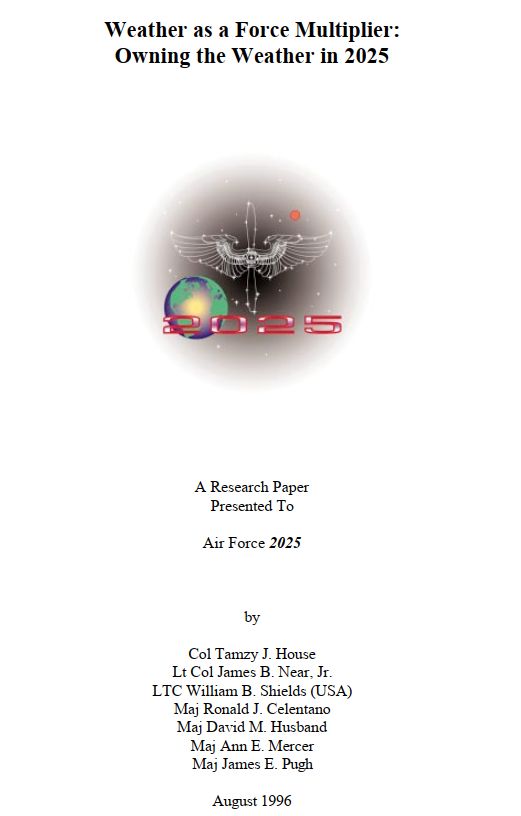USAF Weather as Force Multiplier
Owning the Weather in 2025
Owning the weather in 2025 is an essay submitted by the airforce, which includes detailed descriptions on weather manipulation, and advancement in tesla technology. The HIGHER ACTIVE AURORAL RESEARCH PROGRAM currently uses this technology out of their base in Alaska. They are a gigantic think tank, funded by the Project for a New American Century.

PDF – USAF Weather Force Multiplier Owning Weather 2025
The document “Weather as a Force Multiplier: Owning the Weather in 2025,” published by the United States Air Force (USAF) in 1996, outlines a strategic vision for the potential use of weather modification to achieve military objectives. Here are the key points and analysis of the document:
1. **Purpose and Vision**: The primary goal of this document is to explore the feasibility and strategic advantages of weather modification in future military operations. The document suggests that by 2025, advancements in technology could allow the USAF to control weather patterns to a significant extent, thereby providing a strategic advantage in various military scenarios.
2. **Technological Applications**: The paper discusses several technologies that could be used for weather modification, including:
– **Cloud Seeding**: Enhancing precipitation or dispersing fog and clouds to improve visibility for operations.
– **Ionospheric Modification**: Using high-frequency radio waves to modify the ionosphere to disrupt enemy communications or enhance own communication systems.
– **Storm Modification**: Influencing storm systems to either avoid them or potentially use them as tactical advantages.
3. **Strategic and Tactical Benefits**: The document highlights how controlling weather could help shape the battlefield environment. For example, altering weather conditions could hinder enemy movements, obscure their surveillance capabilities, and improve conditions for friendly forces. The ability to induce or prevent rain, fog, or storms could directly affect ground, air, and naval operations.
4. **Ethical and Legal Considerations**: The paper acknowledges potential ethical and legal issues, particularly with the Environmental Modification Convention (ENMOD), which restricts the military or hostile use of environmental modification techniques. It emphasizes the importance of international cooperation and compliance with existing treaties.
5. **Implementation Challenges**: The document recognizes significant technical, operational, and political challenges in developing and deploying such technologies. These include scientific uncertainties, the complexity of weather systems, and potential unintended consequences.
6. **Research and Development**: Recommendations for future research and development focus on advancing scientific understanding of weather processes, developing precise modeling and prediction capabilities, and creating technologies capable of inducing desired weather changes with minimal collateral effects.
Overall, while the document presents an ambitious vision of weather modification as a military tool, it also underscores the complexity and potential risks associated with such efforts. It serves more as a speculative exploration of future capabilities rather than a concrete plan for implementation.
For more details, you can access the full document through the Defense Technical Information Center or the Internet Archive.
Sources:
– [Internet Archive](https://ia601605.us.archive.org/35/items/WeatherAsAForceMultiplier/WeatherAsAForceMultiplier.pdf)
– [Defense Technical Information Center](https://apps.dtic.mil/sti/citations/ADA333462)
– [ClimateViewer News](https://climateviewer.com)
The Complex Interactions of Chemtrails, NEXRAD Radar, and HAARP in Weather Modification
Weather modification has long been a topic of fascination and controversy. Proponents of geoengineering and atmospheric manipulation argue that these technologies can help mitigate climate change and manage extreme weather events. Critics, however, raise concerns about unintended consequences and ethical implications. Among the most debated components in weather modification theories are chemtrails, NEXRAD radar, and the High-Frequency Active Auroral Research Program (HAARP). This blog post evaluates how these technologies might interact to modify weather on a regional or localized basis, with a focus on dimming or sun shielding, as well as geoengineering, as explored by internet maven Dane Wigington.
Chemtrails: The Foundation of Weather Modification Theories
Chemtrails, or chemical trails, are believed by some to be deliberate releases of substances into the atmosphere by aircraft. Unlike contrails, which are simply water vapor, chemtrails are thought to contain a mix of chemicals, including aluminum, barium, and strontium, aimed at manipulating weather patterns. Proponents suggest that these substances can reflect sunlight (solar radiation management) and alter precipitation patterns.
– **Solar Radiation Management (SRM)**: By reflecting sunlight back into space, SRM aims to reduce the Earth’s temperature and combat global warming. Chemtrails are theorized to play a crucial role in this by forming a reflective layer in the stratosphere.
– **Precipitation Control**: Chemicals in chemtrails are thought to act as cloud condensation nuclei, promoting or inhibiting rainfall depending on the desired outcome.
NEXRAD Radar: The Invisible Hand in Weather Control
NEXRAD (Next-Generation Radar) is a network of high-resolution Doppler radars used primarily for weather observation. Some theorists, including Wigington, propose that NEXRAD can influence weather patterns by manipulating atmospheric conditions.
– **Radar-Induced Precipitation**: It is suggested that NEXRAD can stimulate or suppress precipitation by emitting electromagnetic waves that interact with particles in the atmosphere.
– **Weather Steering**: By heating specific regions of the atmosphere, NEXRAD could potentially steer weather systems, affecting storm paths and intensities.
HAARP: The Master Controller
HAARP, a research program based in Alaska, was initially designed to study the ionosphere. However, it has been the subject of numerous conspiracy theories, alleging it can control weather, disrupt communications, and even trigger natural disasters.
– **Ionospheric Heating**: HAARP’s powerful radio transmitters can heat localized regions of the ionosphere, leading to changes in atmospheric pressure and dynamics. This can theoretically influence weather patterns over large areas.
– **Weather Modification**: By altering the ionosphere, HAARP might indirectly affect the troposphere, where most weather occurs, potentially controlling weather on a regional scale.
Interactions and Implications
The interaction between chemtrails, NEXRAD radar, and HAARP is complex and speculative. However, understanding their potential synergies can provide insight into weather modification theories:
– **Combined Effects on Solar Radiation**: Chemtrails could enhance the sun-dimming effect by spreading reflective particles, while NEXRAD and HAARP might modulate the distribution and density of these particles, optimizing the reflective layer.
– **Enhanced Precipitation Control**: Chemtrails introduce particles that NEXRAD and HAARP could then manipulate, either by promoting cloud formation or dispersal, depending on the desired weather outcome.
– **Localized Weather Control**: The precise application of these technologies could theoretically allow for localized weather modification, such as preventing rainfall over a specific area or enhancing snowfall in another.
Dane Wigington’s Perspective
Dane Wigington, a prominent figure in the geoengineering debate, argues that these technologies are already in use and pose significant risks to the environment and human health. He advocates for greater transparency and public awareness about geoengineering practices and their potential impacts.
– **Environmental Concerns**: Wigington highlights the potential for soil and water contamination from chemicals used in chemtrails.
– **Health Risks**: The long-term exposure to substances like aluminum could have serious health implications.
– **Ethical Considerations**: The unilateral deployment of geoengineering technologies raises ethical questions about consent and the right to modify natural systems.
Conclusion
While the interactions between chemtrails, NEXRAD radar, and HAARP remain speculative and controversial, they form a compelling narrative in the discourse on weather modification and geoengineering. As technologies advance, the need for transparent research and ethical considerations becomes increasingly critical. Dane Wigington’s work underscores the importance of public scrutiny and dialogue in addressing these complex issues.
For further reading and more detailed explorations of these topics, consider the following sources:
– [Geoengineering Watch](https://www.geoengineeringwatch.org)
– [ClimateViewer News](https://climateviewer.com)
– [USAF Document on Weather Modification](https://ia601605.us.archive.org/35/items/WeatherAsAForceMultiplier/WeatherAsAForceMultiplier.pdf)【6†source】【7†source】【9†source】
